Women on the 2020 campaign trail are being treated more negatively by the media
Update, April 24, 2019: This project is ongoing, and we are adding more data to the original analysis as we go. See new analysis of the full text of 1,397 articles below. In June, we plan to release a more comprehensive report to contextualize the sentiment scoring method we have employed so far.
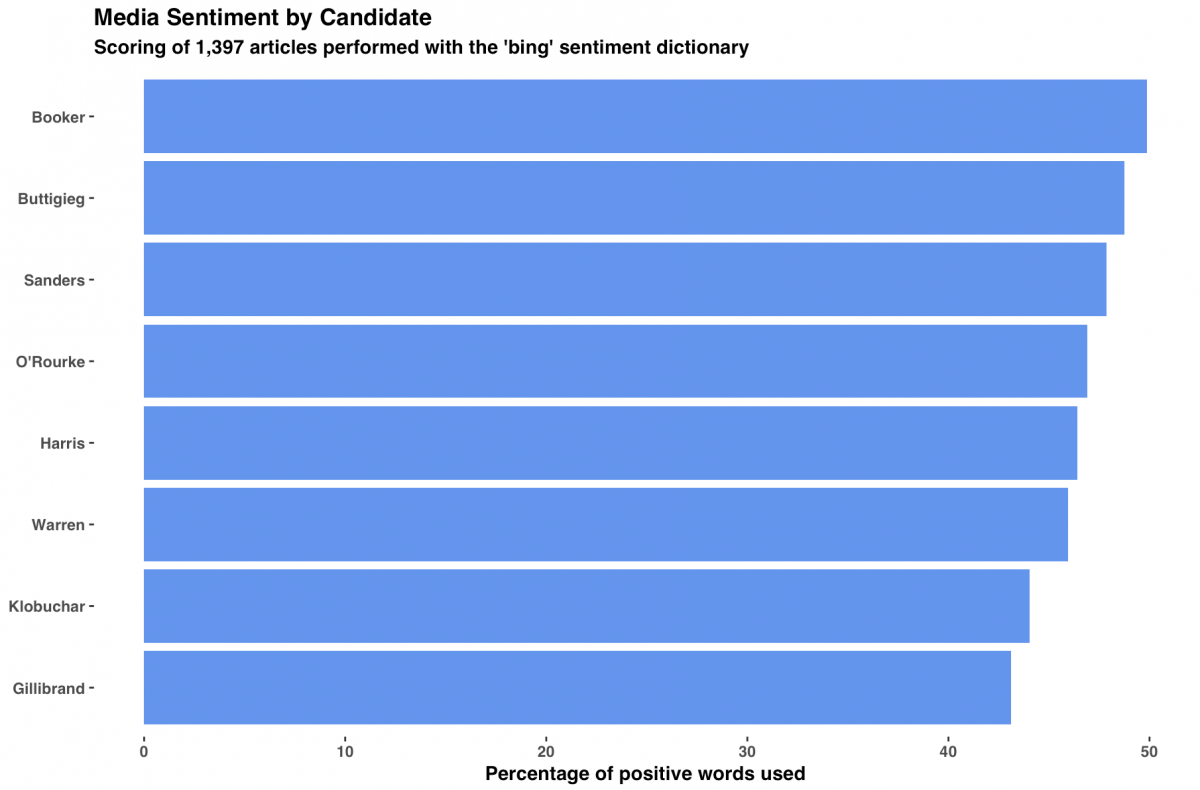
Female candidates running for president are consistently being described in the media more negatively than their male counterparts. That’s what we’ve concluded after an analysis of 130 articles from mainstream news outlets. It’s a disconcerting trend in the 2020 election coverage.
We pointed this out in our first Storybench 2020 Election Coverage Tracker update last month. But with the addition of 70 more articles to our database, the picture has become even clearer.
Before moving on, a quick refresher on methodology: We’re focusing on the five most-read news websites according to Amazon’s Alexa service: The Washington Post, The New York Times, The Huffington Post, CNN, and Fox News. “Substantial” stories were chosen (a rough rule of thumb was for articles to be over 500 words). While randomness cannot be guaranteed, given that this was human-selected, the content of the articles themselves were mostly ignored in the selection process. There was no intentional effort to choose articles based on subject matter.
Back to the analysis: Sanders and Booker maintain their perch on the top of the overall sentiment rankings with O’Rourke right behind them. Warren, Klobuchar, Harris, and Gillibrand all place under them. Again, these findings need to be taken with a grain of salt. The sentiment scoring is imperfect, and despite doubling our dataset, it is still too small to draw any certain conclusions. But the findings beg the question: What exactly is causing this apparent disparity in media portrayal?
One possibility is that the four female candidates have simply been dealing with scandals at a higher rate than their male counterparts. Warren has the infamous ancestry test, Klobuchar has the comb, Harris has her prosecutorial past, and Gillibrand has been accused of mishandling sexual assault allegations in her office.
But another possibility is that the women are simply facing more scrutiny than the men.
“This idea that [female candidates] have more scandals in their past could have to do with how women’s behavior is viewed,” said Meredith Conroy, a professor at California State at San Bernardino and the author of “Masculinity, Media and the American Presidency.”
Certain traits, Conroy argues, are viewed positively or neutrally when a man embodies them but negatively when a woman does. In a world where femininity is too often aligned with weakness or timidness, failure to conform to those stereotypes can result in differences in public perceptions.
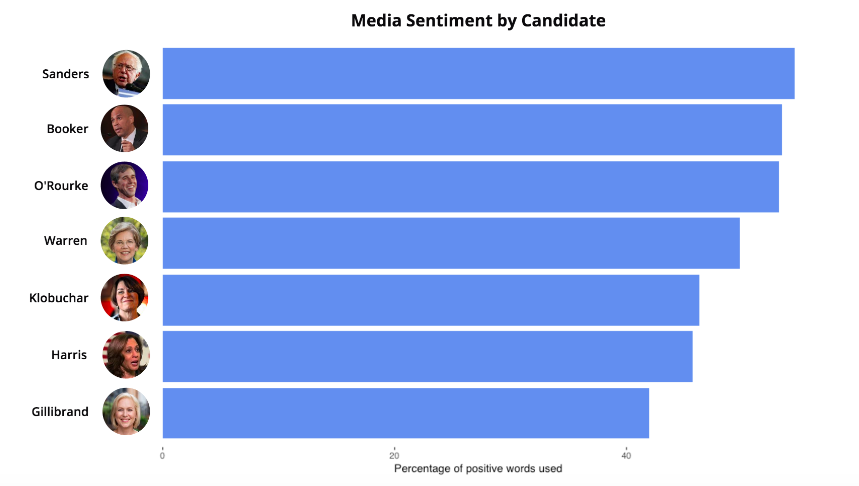
Valerie Sperling, a professor of political science at Clark University and an expert on gender politics, sees this as putting female politicians in a difficult spot. “Women in our society are supposed to be pleasing, kind, and somewhat deferential… so a woman who comes across as decisive and tough may also be frowned upon for being ‘nasty’ or ‘shrill’ — for ostensibly violating feminine stereotypes of ‘likeability,’” she told me.
This, of course, mirrors much of the debate around the coverage of Hillary Clinton in 2016. And if the graphic above represents a real trend, then not much has appeared to change in the two and a half years since. In terms of possible solutions, Conroy suggests that media outlets pay more attention to the subtle ways in which they might be shortchanging women.
“Be conscious of criticisms of candidates that invoke a double standard,” she said. “In other words, is the behavior bad because it doesn’t conform to our political norms, or [is it] because the behavior is violating a gender norm, and therefore wouldn’t be reported if the candidate were male?”
Sperling echoed a similar sentiment, pointing to the 2016 Democratic primary: “I think a good first step would be for media outlets to familiarize themselves with the fact that standards of behavior are different for women and men as candidates. Hillary Clinton was frequently criticized for her voice and for ostensibly ‘shouting,’ whereas Bernie Sanders was not criticized for that, as it is seen as appropriate for men to raise their voices, but not for women to do so.”
The bias in the media, however, goes beyond these double standards. Pointing to research done by the Harvard’s Shorenstein Center, Conroy outlined how articles can fall into one of several buckets; There’s horse race coverage, policy coverage, personality coverage, and controversy coverage. Too often, women receive less policy issue coverage than their male counterparts.
Here, again, Elizabeth Warren and Bernie Sanders make for a handy comparison. Warren has centered her campaign on specific policy proposals and ideas, yet is dogged by questions about her ancestry test, likeability, and electability. Below, in our analysis of unique words, we can see that the situation has improved somewhat since the last update, with her tech proposals making their way onto the list. But compare her list to Sanders’, and you’ll see that no word on his refers to personality or personal issues.
Even when coverage is seemingly positive, the fact that it focuses on personal issues can subconsciously push forth ideas on who is actually a formidable candidate. “In my work, we call this soft sexism,” said Conroy. “Coverage that talks about [candidates’] families or their personalities can reinforce perceptions of the viability of a candidate.”
Unfortunately, according to Conroy, addressing this can be tricky. Even articles that attempt to bring these biased ideas of “authenticity” and “viability” out into the open can reinforce the very messages they want to counter. Vox, for instance, recently published a piece titled “The 2020 authenticity primary,” which had the following lede:
“Beto O’Rourke quite literally drips with authenticity; he’s the cool punk rocker dad on the campaign trail. Joe Biden’s love of trains and off-color jokes has earned him the affectionate nickname Uncle Joe. No one doubts Bernie Sanders’s passion for democratic socialism. But some candidates have a harder time proving they’re the real deal.”
The article, which went on to address the gender divide, certainly shined a light on the very issues discussed here. But for a casual reader, it isn’t hard to see how it could solidify the perception that the male candidates are inherently more authentic. “I get what [Vox] is doing, but it made my blood boil,” said Conroy. “To talk about women, you have to talk about their authenticity, which can end up reinforcing that very idea in the first place.”
Which words are associated with each candidate?
We introduced this analysis in our last post, but will update it with every addition to the Storybench 2020 Election Coverage Tracker as more articles are added to the dataset. As a reminder, we found these terms using tf-idf, which pulls out unique words used to describe each presidential aspirant.
The stories of Klobuchar’s reputation as a boss weren’t included in our last update, but they have clearly made their mark in this one. With “boss,” “comb,” “salad,” and “binder” all in the top ten, it looks like the senator will have to dedicate a serious amount of time to proving that she’s “Minnesota nice.” Her appearance at the Gridiron Club dinner might have been a good start. Her keynote speech there, in which she poked fun at her choice in utensils, got high reviews, hence the inclusion of “funny.”
Bernie’s rally in Brooklyn catapulted the borough’s name to the top of the list, but Sanders’ main words are relatively unchanged. He is still dealing with the socialist label, and his focus on a political revolution and tuition-free college are resonating with the media. “CPAC” is a surprise, sneaking in at the bottom, but can be explained by conservatives’ obsession with the socialist threat, apparently spearheaded by Sanders.
Unfortunately, these articles were collected before the news of O’Rourke’s hacker past were revealed, so there are no computer-related terms here. But his Texas roots are repeatedly emphasized with the media, as is the tight election he lost to Ted Cruz. Given his message of unification, O’Rourke would likely be happy to see “interconnected” make the list. And that “254” at the end? It refers to how he visited all 254 Texas counties, a fact the media is happy to highlight.
Again, Booker has perhaps the most boring list of all the candidates. His work on the educational system and in Newark are highlighted throughout, as are the names of other politicians he worked (or squared off) with. Also, the media doesn’t seem to want to let go of Booker’s curious “I am Spartacus!” moment from the Kavanaugh hearings.
This update brings better news for Warren than the last one. Her Native American ancestry scandal has been focused on less by reporters, as evidenced by the lower rankings of “native,” “dna,” and “tribal.” Her promise to break apart the big tech companies, meanwhile, has dominated the coverage, with four of her top five most unique words involving this major stance.
The California senator didn’t get caught up in some sort of sultry scandal; “Sex” assumes the top spot here due to her declaration of support for the decriminalization of sex work. Harris is dealing with a different sort of scandal, however, which might have also caused her drop in the sentiment rankings—the inclusion of “lab” refers to her handling of an unreliable drug lab technician during her tenure as a prosecutor. The episode, which re-emerged into the public eye recently, has led some to question her leadership.
With dismal polling numbers and a troubling lack of endorsements, Gillibrand could really use some positive press. Based on the list above, it doesn’t look like she’s getting it. Allegations came out that she mishandled a sexual assault claim within her office, a bad story that becomes worse when one remembers that Gillibrand was an outspoken advocate of the #MeToo movement. Hence, “franken” at #3.
The New York senator is getting less coverage than her counterparts, and when she does get it, it’s mostly negative. That unfortunately seems to be the rule, not the exception.
- How are Iowa and New Hampshire outlets covering 2020? - April 8, 2019
- Women on the 2020 campaign trail are being treated more negatively by the media - March 29, 2019
- Sexism through sentiment analysis: Looking at the media’s coverage of 2020 candidates - February 28, 2019
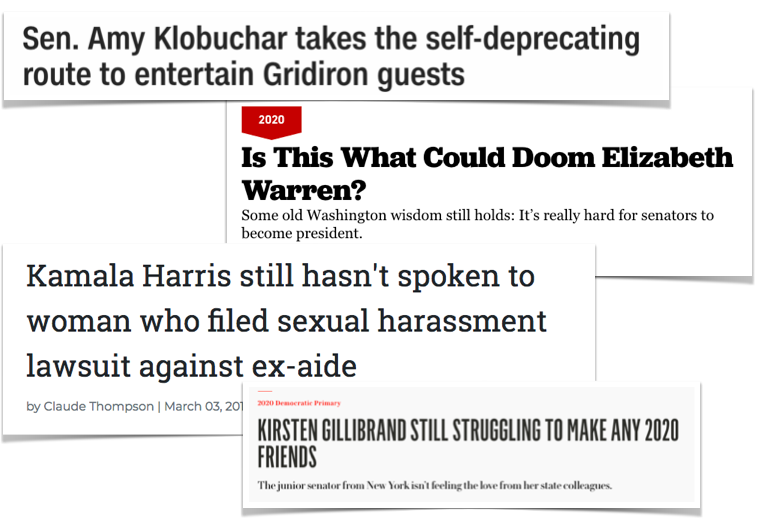
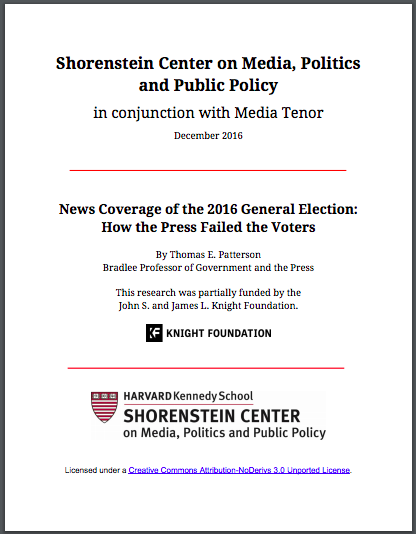

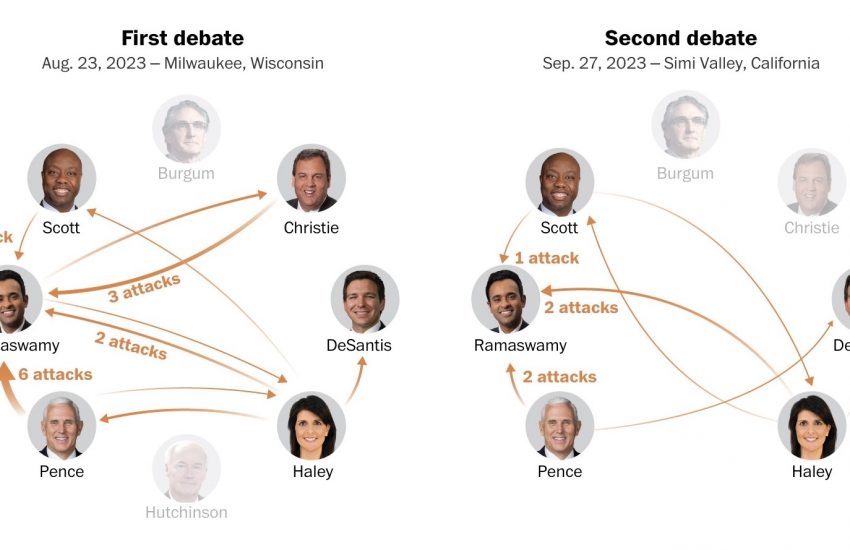



Two structural points and then one conclusion.
You do not give the period of time over which the articles are being collected. This is important because 130 articles over the period of three days may be a good sample size. 130 articles over three months is a completely different matter.
That leads to my second point. There is nothing written that explains what “mainstream media” means. Was this in just the New York Times, Washington Post, and Associated Press, or was a much larger number of publications covered? In giving a extremely cursory look at the data, I saw the phrase “opinion writer” at least one. If you are including opinion pieces, that isn’t the same thing as disinterested reporting and will skew conclusions in a direction not warranted.
Saying that, let’s talk about one other item. You wrote that, “these findings need to be taken with a grain of salt. The sentiment scoring is imperfect, and despite doubling our dataset, it is still too small to draw any certain conclusions. ” Yet, in your lede you very clearly conclude women candidates , “are consistently being described in the media more negatively than their male counterparts,” and reiterate that conclusion in the second paragraph when asking, “What exactly is causing this disparity in media portrayal?”
This may be a legitimate story. However, there isn’t enough data to support the claim being made while at the same time telling readers they should reach a conclusion.
If you have any questions, please do not hesitate to drop me a note.
Pretty! This has been a really wonderful post. Many thanks for providing these details.
Your blog has become my go-to source for inspiration and motivation I am so grateful for the valuable content you provide